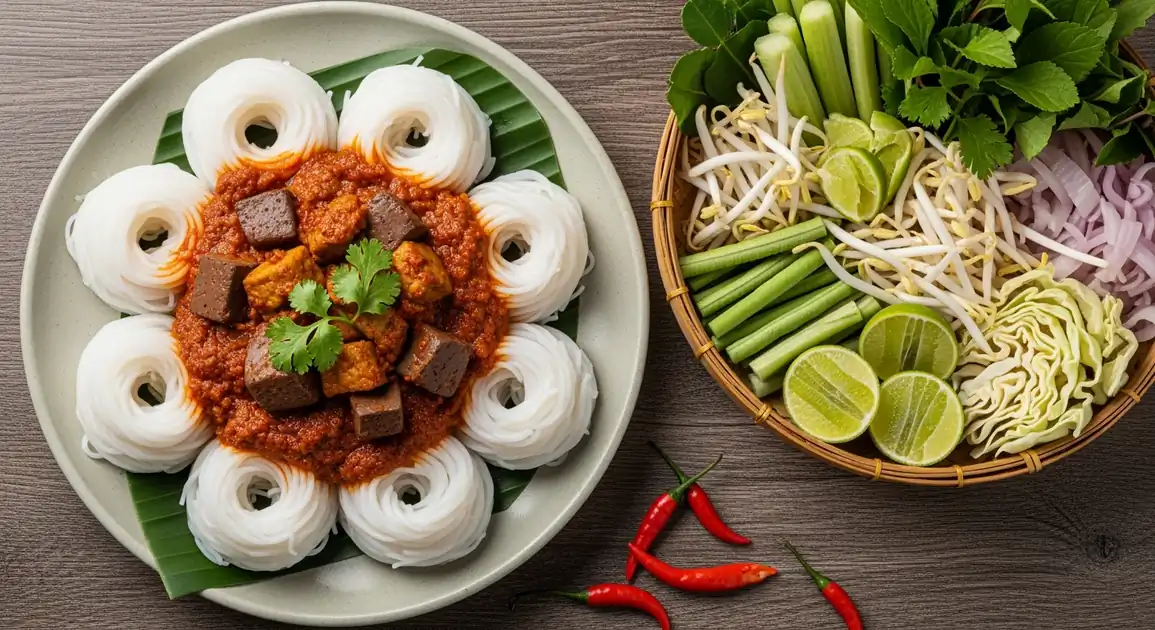Khanom Jeen (Fermented Rice Noodles)
ขนมจีน

Description
Phuket's version of Khanom Jeen reflects its southern Thai and Peranakan influences, featuring intensely spicy, aromatic curry sauces that often incorporate seafood, tropical herbs, and sometimes coconut milk. The island's position as a historical trading hub brings unique dimensions to the dish, with Nam Ya Tai (southern fish curry) being the predominant sauce variant. Fresh seafood additions and locally grown ingredients create a distinctly Phuket experience, popular among locals at morning markets and increasingly available in tourist areas with adapted spice levels.
Dietary Information
Serving information
Serving style
Phuket-style typically features Nam Ya Tai (southern curry) or other spicy sauces already ladled over the noodles. Served with an abundant array of fresh vegetables, including unique southern items like young banana flowers, coconut shoots, and wild ferns when available. Often accompanied by small dishes of extra condiments for customization.
Quick facts
Most local vendors operate 6 AM - 1 PM. Tourist area restaurants may serve Khanom Jeen until evening hours (9 PM), but morning is still optimal for freshness.
Safety Tips
What to Look For
-
Noodles that appear fresh and moist, arranged in neat coils
Fresh Khanom Jeen should be slightly glossy, soft, and arranged in tidy coils. They should not look dried out, sticky, or discolored.
-
Actively simmering or steaming curry sauces
Proper temperature maintenance is crucial for safety. Curries should be kept hot (visibly steaming) to prevent bacterial growth, especially since they often contain meat and fish products.
-
Clean, organized condiment and vegetable stations
Fresh vegetables should be crisp, bright, and stored separately from raw ingredients. Look for vendors who replenish vegetables frequently and keep them covered when possible.
-
High customer turnover and local popularity
Busy stalls ensure fresh ingredients and indicate quality recognized by locals. Morning markets typically have the freshest noodles made that same day.
What to avoid
-
Noodles left uncovered for extended periods
Exposed noodles can collect dust and insects. Good vendors keep noodles covered when not actively serving.
-
Curry sauces sitting at room temperature
Sauces containing meat, fish, or coconut milk can develop harmful bacteria when left at room temperature, especially in Thailand's heat.
-
Reused vegetables or condiments from previous customers
Some vendors might reuse untouched vegetables. Watch to ensure fresh vegetables are provided for each customer.
-
Dirty utensils or serving areas
Look for clean ladles, plates, and work surfaces. Cross-contamination between raw and cooked ingredients is a risk at less hygienic stalls.
Price information
Price range
Budget tips
- Local markets in Phuket Town like Downtown Market offer the best value at 50-70 THB per plate.
- Tourist areas in Patong or Kata may charge 80-120 THB for essentially the same dish.
- Self-serve vegetables are often unlimited - take advantage to make a more filling meal.
- Some vendors offer smaller portions at reduced prices if you ask.
Value indicators
- Vibrant, aromatic curry sauce with visible fresh herbs and spices.
- Inclusion of fresh seafood like crab meat or shrimp in the curry.
- Tropical vegetable assortment including young coconut shoots when in season.
- House-made condiments with authentic southern Thai flavors.
- Inclusion of rare southern herbs not commonly found elsewhere.
Where to Find This Dish
Phuket Old Town
The historic center has several authentic Khanom Jeen vendors, particularly in and around the morning markets.
Downtown Market, Limelight Avenue area, Thai Hua Museum vicinity
Early Morning, Mid-Morning
Patong/Karon/Kata
Tourist areas have adapted versions, sometimes with reduced spice levels but still authentic sauce profiles.
Local food courts, Jungceylon area, Side street vendors
Mid-Morning, Lunch
Local Residential Areas
More authentic vendors can be found in areas like Kathu, where locals live and shop.
Kathu Fresh Market, Local morning markets
Early Morning
Vendor Tips
- Ask for spice level adjustment if needed - southern Thai curries are notoriously spicy.
- Look for vendors who make their curry paste from scratch - they often have mortars visible.
- The freshest seafood additions are typically available in the early morning.
How to Order
Regional Variations
-
Khanom Jeen Pla Tu
(ขนมจีนปลาทู)
A Phuket specialty featuring mackerel in the curry sauce, reflecting the island's fishing tradition.
-
Khanom Jeen Nam Ya Pu
(ขนมจีนน้ำยาปู)
Crab meat version especially popular in seafood-rich Phuket, sometimes including crab roe for richness.
-
Khanom Jeen Pak Tai
(ขนมจีนปักษ์ใต้)
A robust southern-style version with intensely spicy curry, often containing multiple types of seafood and distinct southern herbs.
Cultural context
History
Khanom Jeen has ancient roots in Thailand, with influences from Mon culture and possibly originating from interactions with Khmer and Chinese cuisines centuries ago. The name derives from 'kanom' (snack) and 'jin' (Chinese), suggesting its cultural connections. Traditionally, making these noodles was a communal activity in villages, with the labor-intensive process of soaking rice, fermenting the dough, and pressing the noodles through specialized equipment bringing people together. Each region developed distinctive curry sauces to accompany the noodles, reflecting local ingredients and tastes, making Khanom Jeen an edible map of Thailand's culinary diversity.
Local significance
Khanom Jeen in Phuket represents the island's unique cultural blend of Thai, Chinese, and Malay influences, particularly evident in the intense, complex flavors of the curries paired with the noodles.
Eating customs
- Southern Thais often add extra fish sauce, lime, and chili to already spicy curries.
- Fresh betel leaves sometimes serve as edible wraps for small bites of noodles.
- Some locals alternate bites with sips of cool herb drinks to balance the heat.